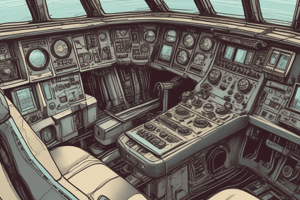Podcast
Questions and Answers
What component in a turbine-powered aircraft converts the variable engine rpm to an alternator input speed of 12,000 rpm?
What component in a turbine-powered aircraft converts the variable engine rpm to an alternator input speed of 12,000 rpm?
- Hydraulic motor
- CSD (correct)
- Generator
- IDG
How does the Quick Attach/Detach (QAD) adapter facilitate the maintenance of a turbine aircraft?
How does the Quick Attach/Detach (QAD) adapter facilitate the maintenance of a turbine aircraft?
- Converts engine power to electrical power
- Is an integral part of the IDG system
- Allows quick removal and replacement of the generator and CSD assembly (correct)
- Regulates the AC frequency to 400 Hz
What is the purpose of the Integrated Drive Generator (IDG) in modern turbine-powered aircraft?
What is the purpose of the Integrated Drive Generator (IDG) in modern turbine-powered aircraft?
- To operate at 9000 rpm
- To drive the hydraulic motor
- To convert AC to DC power
- To reduce the weight and size of the traditional two-unit system (correct)
Which component cannot be replaced separately from the Integrated Drive Generator (IDG)?
Which component cannot be replaced separately from the Integrated Drive Generator (IDG)?
What is the typical rotation speed range of older alternators in turbine-powered aircraft?
What is the typical rotation speed range of older alternators in turbine-powered aircraft?
What does the Constant Speed Drive (CSD) in a turbine aircraft contain that helps in RPM conversion?
What does the Constant Speed Drive (CSD) in a turbine aircraft contain that helps in RPM conversion?
What is the purpose of oil cooling in a generator section?
What is the purpose of oil cooling in a generator section?
In case of a complete failure of engine-driven generators, what powers emergency generators in aircraft?
In case of a complete failure of engine-driven generators, what powers emergency generators in aircraft?
What type of alternators are emergency generators typically equipped with?
What type of alternators are emergency generators typically equipped with?
What is the function of the hydraulic motor-driven emergency generator system on larger transport aircraft like the Airbus A330?
What is the function of the hydraulic motor-driven emergency generator system on larger transport aircraft like the Airbus A330?
Why do emergency AC generation systems on aircraft typically use hydraulic motors?
Why do emergency AC generation systems on aircraft typically use hydraulic motors?
What is the key advantage of emergency generators being constructed with permanent magnet rotors?
What is the key advantage of emergency generators being constructed with permanent magnet rotors?
What causes the external power relay to open?
What causes the external power relay to open?
What happens when the GCB of the second aircraft engine closes?
What happens when the GCB of the second aircraft engine closes?
How are the essential AC loads supplied under normal operating conditions?
How are the essential AC loads supplied under normal operating conditions?
What happens when one of the generators becomes inoperative?
What happens when one of the generators becomes inoperative?
What is the purpose of connecting both generator buses together by closing the BTB?
What is the purpose of connecting both generator buses together by closing the BTB?
What does supplying power via auxiliary contacts of a tripped GCB to the BTB's close coil achieve?
What does supplying power via auxiliary contacts of a tripped GCB to the BTB's close coil achieve?
What is the purpose of the three-phase contactor in an aircraft AC external power system?
What is the purpose of the three-phase contactor in an aircraft AC external power system?
Why is the external power contactor de-energized when an onboard generating source is brought online?
Why is the external power contactor de-energized when an onboard generating source is brought online?
What happens when any inconsistency in the input external power is detected?
What happens when any inconsistency in the input external power is detected?
Why is it important to remove ground power when onboard generating sources are brought online?
Why is it important to remove ground power when onboard generating sources are brought online?
What role does the external AC power schematic play in an aircraft's electrical system?
What role does the external AC power schematic play in an aircraft's electrical system?
Why is the DC external power receptacle designed with two large pins and a smaller pin?
Why is the DC external power receptacle designed with two large pins and a smaller pin?
What purpose does the plug design with different-sized prongs serve?
What purpose does the plug design with different-sized prongs serve?
Why is the smaller pin in the DC external power receptacle shorter than the main pins?
Why is the smaller pin in the DC external power receptacle shorter than the main pins?
What safety feature is implemented by the DC external power receptacle design?
What safety feature is implemented by the DC external power receptacle design?
Why is it important for the external power relay to de-energize before the main pins are disengaged during plug withdrawal?
Why is it important for the external power relay to de-energize before the main pins are disengaged during plug withdrawal?
What event triggers the de-energization of the external power relay?
What event triggers the de-energization of the external power relay?
Flashcards are hidden until you start studying
Study Notes
Hydraulic Motor and Generator
- The pump supplies hydraulic pressure to a hydraulic motor, which varies the ratio of input rpm to output rpm to maintain a constant output rpm to drive the generator and maintain an AC frequency of 400 Hz.
- Quick Attach/Detach (QAD) adapter allows for quick removal and replacement of the generator and CSD assembly in a matter of minutes.
Integrated Drive Generator (IDG)
- The IDG contains both the generator and the CSD in one unit, reducing weight and size compared to traditional two-unit systems.
- The generator is an integral part of the IDG and cannot be replaced separately.
- The CSD converts variable engine rpm to an alternator input speed of 12,000 rpm.
- Oil cooling allows for a higher-speed rotor within the generator section, resulting in a lighter, more compact generator.
Emergency Power Generation
- Emergency power generation is installed on many aircraft to supply essential power in the event of losing all normal power generation.
- Emergency generators are typically permanent magnet alternators and do not require battery power to function.
- Hydraulic electrical generating system (HEGS) uses a hydraulic motor-driven emergency generator system to provide emergency or standby electrical power.
Hydraulic Electrical Generating System (HEGS)
- The system consists of a hydraulic motor-driven generator designed to restore the essential power network in case of the loss of both normal main generator buses.
- The generator is driven by a hydraulic motor supplied by an airstream-driven hydraulic pump.
External and Ground Power
- External AC power systems incorporate circuits that monitor input voltage and phase rotation.
- If any inconsistency in input external power is sensed, the application of power to aircraft systems is inhibited by the three-phase contactor.
- The DC external power receptacle has specific design features to prevent incorrect connection and ensure safe power supply.
Studying That Suits You
Use AI to generate personalized quizzes and flashcards to suit your learning preferences.




